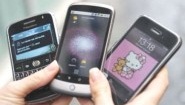Deep Sleep Wi-Fi Could Improve Phone Battery Life

Boffins have come with an “idle listening” fix for smartphones to dramatically improve battery life
Researchers in America will today describe an ingenious way to extend the battery life of smartphones and other electronic equipment.
University of Michigan computer science and engineering professor Kang Shin, and doctoral student Xinyu Zhang will reveal their solution at a mobile technology conference in Las Vegas.
They claim that their new “subconscious mode” for smartphones and other Wi-Fi-enabled devices could extend battery life by as much as 54 percent for users on the busiest networks.
Idle Listening
Limited battery life is proving to be the bane of many of today’s smartphone users.
Of course one of the most common ways for smartphone users to preserve their battery life is to turn off Bluetooth and Wi-Fi capabilities, but for those using networked data this is not an option, and users have to rely on their phones’ inbuilt power management.
This certainly helps, but even when a smartphone is in its power saving mode and is not actively sending or receiving data, it is still on high alert to receive notification of incoming calls or data.
Unfortunately, this so called “idle listening” consumes energy (i.e. battery life), as it takes place very frequently, even when the phone is in power saving mode. A good way to think about it is to compare the smartphone to a sleeping dog, which seems to sleep with one ear open for unusual sounds.
This “always on the alert” ability is very taxing.
 So in order to preserve battery life, the researchers created a new, more energy efficient method, which they have called E-MiLi (Energy-Minimizing Idle Listening).
So in order to preserve battery life, the researchers created a new, more energy efficient method, which they have called E-MiLi (Energy-Minimizing Idle Listening).
This method makes smartphones perform this idle listening much more efficiently.
Power Consumption
The researchers conducted an experiment to see how much time phones spend keeping one ear open when on real Wi-Fi networks.
This analysis revealed that devices in power-saving modes can spend 60 to 80 percent of their time in idle listening, depending on the amount of network traffic. They also demonstrated that phones in idle listening mode expend roughly the same amount of power as they do when they’re fully awake.
“My phone isn’t sending or receiving anything right now,” Professor Shin said, lifting his power-skinned iPhone (as reported by a University of Michigan press release), “but it’s listening to see if data is coming in so I can receive it right away. This idle listening often consumes as much power as actively sending and receiving messages all day.”
He said that E-MiLi helps in this regard as it slows down the Wi-Fi card’s clock by up to 1/16 its normal frequency, but jolts it back to full speed when the phone notices information coming in.
“It’s well known that you can slow a device’s clock to save energy” said Professor Shin. “The hard part was getting the phone to recognise an incoming message while it was in this slower mode.”
“We came up with a clever idea,” Shin said. “Usually, messages come with a header, and we thought the phone could be enabled to detect this, as you can recognise that someone is calling your name even if you’re 90 percent asleep.”
Firmware Update
And the results are staggering. When used with power-saving mode, the researchers said that E-MiLi is capable of reducing energy consumption by around 44 percent for 92 percent of mobile devices in real-world wireless networks.
But as so often is the case there is a drawback.
Firstly the smartphone needs to have the processor-slowing software installed on it, and E-MiLi also requires new firmware for phones and computers that would be sending messages. This is because they need the ability to encode the message header (i.e. the recipient’s address) in a new and detectable way.
This firmware would need to be adopted by Wi-Fi chipset manufacturers, as well as smartphone and computer makers.
But Shin points out that E-MiLi is compatible with today’s models, so messages sent with future devices that use E-MiLi’s encoding would still be received as usual on smartphones without E-MiLi.
Professor Shin and doctoral student Zhang will present their new power management approach at the ACM International Conference on Mobile Computing and Networking in Las Vegas on 21 September.
Meanwhile the search for better battery technology continues.
Earlier this month, British scientists at the University of Leeds invented a jelly lithium battery. These flexible polymer gel batteries can be shaped and bent to fit virtually any device and can be made just nanometres thick at a rate of ten metres per minute.